
The First and Only Weekly Online Fanzine Devoted to the Life and Works of Edgar Rice Burroughs |
 |

The First and Only Weekly Online Fanzine Devoted to the Life and Works of Edgar Rice Burroughs |
 |
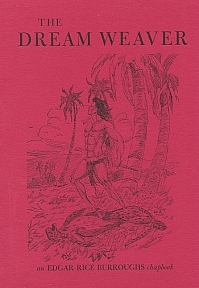
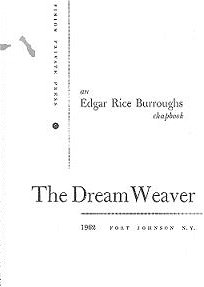
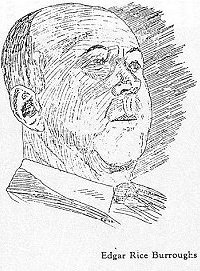
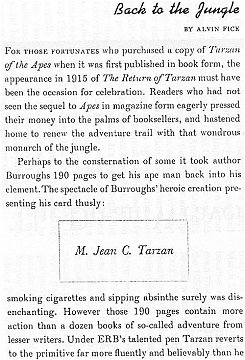 |
I have wrought my simple plan
Back to the Jungle
by Alvin Fick
Perhaps to the consternation of some it took author Burroughs 190 pages to get his ape man back into his element. The spectacle of Burroughs' heroic creation presenting his card thusly: smoking cigarettes and sipping absinthe surely was disenchanting. However those 190 pages contain more action than a dozen books of so-called adventure from lesser writers. Under ERB's talented pen Tarzan reverts to the primitive far more fluently and believably than he |
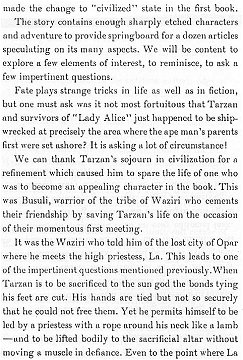
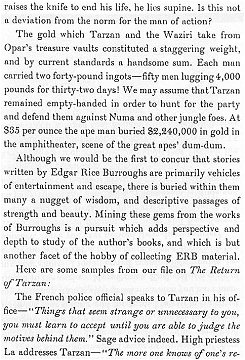 |
made the change to "civilized" state in the first
book.
The story contains enough sharply etched characters and adventure to provice springboard for a dozen articles speculating on its many aspects. We will be content to explore a few elements of interest, to reminisce, to ask a few impertinent questions. Fate plays strange tricks in life as well as in ficiton, but one must ask was it not most fortuitous that Tarzan and survivors of "Lady Alice" just happened to be shipwrecked at precisely the area where the apeman's parents first were set ashore? It is asking a lot of circumstance! We can thank Tarzan's sojourn in civilization for a refinement which caused him to spare the life of one who was to become an appealing character in the book. This was Busuli, warrior of the tribe of Waziri who cements their friendship by saving Tarzan's life on the occasion of their momentous first meeting. It was the Waziri who told him of the lost city of Opar where he meets the high priestess, La. This leads to one of the impertinent questions mentioned previously. When Tarzan is to be sacrificed to the sun god the bonds tying his feet are cut. His hands are tied but not so securely that he could not free them. Yet he permits himself to be led by a priestess with a rope around his neck like a lamb -- and to be lifted bodily to the sacrificial altar without moving a muscle in defiance. Even to the point where La raises the knife to end his life, he lies supine. Is this not a deviation from the norm for the man of action? The gold which Tarzan and the Waziri take from Opar's treasure vaults constituted a staggering weight, and by current standards a handsome sum. EAch man carried two forty-pound ingots -- fifty men lugging 4,000 pounds for thirty-two days! We may assume that Tarzan remained empty-handed in order to hunt for the party and defend them against Numa and other juntle foes. At $35 per ounce the ape man buried $2,240,000 in gold in the amphitheater, scene of the great apes' dum-dum. Although we would be the first to concur that stories written by Edgar Rice Burroughs are primarily vehicles of entertainment and escape, there is buried within them a nugget of wisdom, and descriptive passages of strength and beauty. Mining these gems from the works of Burroughs is a pursuit which adds perspective and depth to study of the author's books, and which is but another facet of the hobby of collecting ERB material. Here are some samples from our file on The Return of Tarzan: The French police official speaks to Tarzan in his office -- "Things that seem strange or unnecessary to you, you must learn to accept until you are able to judge the motives behind them." Sage advice indeed. High priestess La addresses Tarzan -- "The more one knows of one's re- |
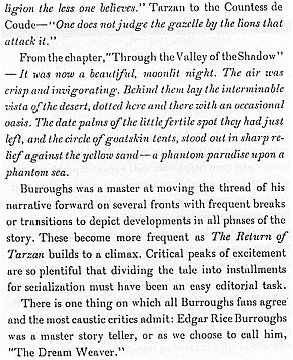
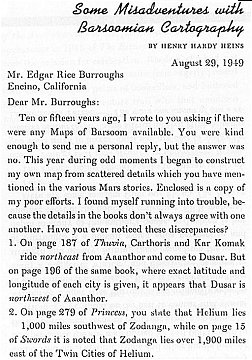 |
ligion the less one believes." Tarzan to the Countess
de Coude -- "One does not judge the gazelle by the lions that attack it."
From the chapter, "Through the Valley of the Shadow" -- It was now a beautiful, moonlit night. The air was crisp and invigorating. Behind them lay the interminable vista of the desert, dotted here and there with an occasional oasis. The date palms of the little fertile spot they had just left, and the circle of goatskin tents, stood out in sharp relief against the yellow sand -- a phantom paradise upon a phantom sea. Burroughs was a master at moving the tread of his narrative forward on several fronts with frequent breaks or transitions to depict developments in all phases of the story. These become more frequent as The Return of Tarzan builds to a climax. Critical peaks of excitement are so plentiful that dividing the tale into installments for serialization must (not) have been an easy editorial task. There is one thing on which all Burroughs fans agree and the most caustic critics admit: Edgar Rice Burroughs was a master story teller, or as we choose to call him, "The Dream Weaver." SOME MISADVENTURES WITH
August 29, 1949
Mr. Edgar Rice Burroughs
Encino, California Dear Mr. Burroughs: Ten or fifteen years ago, I wrote to you asking if there were any Maps of Barsoom available. You were kind enough to send me a personal reply, but the answer was no. This year during odd moments I began to construct my own map from scattered details which you have mentioned in the various Mars stories. Enclosed is a copy of my poor efforts. I found myself running into trouble, because the details in the books don't always agree with one another. Have you ever noticed these discrepancies? 1. On page 187 of Thuvia, Carthoris and Kar Komak ride northeast from Aaanthor and come to Dusar. But on page 196 of the same book, where exact latitude and longitude of each city is given, it appears that Dusar is northwest of Aaanthor. 2. On page 279 of Princess, you state that Helium lies 1,000 miles southwest of Zodanga, while on page 15 of Swords it is noted that Zodanga lies over 1,900 miles east of the Twin Cities of Helium. |
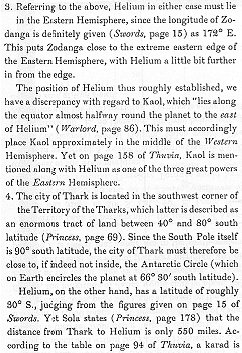
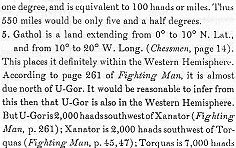 |
3. Referring to the above, Helium in either case must
lie in the Eastern Hemisphere, since the longitude of Zodanga is definitely
given (Swords, page 15) as 172o E. This puts Zodanga close to
the extreme eastern edge of the Eastern Hemisphere, with Helium a little
bit further in from the edge.
The position of Helium thus roughly established, we have a discrepancy with regard to Kaol, which "lies along the equator almost halfway round the planet to the east of Helium" (Warlord, page 86). This must accordingly place Kaol approximately in the middle of the Western Hemisphere. Yet on page 158 of Thuvia, Kaol is mentioned along with Helium as one of the three great powers of the Eastern Hemisphere. 4. The city of Thark is located in the southwest corner of the Territory of the Tharks, which latter is described as an enormous tract of land between 40o and 80o south latitude (Princess, page 69). Since the South Pole itself is 90o south latitude, the city of Thark must therefore be close to, if indeed not inside the Antarctic Circle (which on Earth encircles the planet at 66o 30' south latitude). Helium, on the other hand, has a latitude of roughly 30o S, judging from the figures given on page 15 of Swords. Yet Sola states (Princess, page 178) that the distance from Thark to Helium is only 550 miles. According to the table on page 94 of Thuvia, a karad is one degree, and is equivalent to 100 haads or miles. Thus 550 miles would be only five and a half degrees. 5. Gathol is a land extending from 0o to 10o N. Lat., and from 10o to 20o W. Long. (Chessmen, page 14). This places it definitely within the Western Hemisphere. According to page 261 of Fighting Man, it is almost due north of U-Gor. It would be reasonable to infer from this then than U-Gor is also in the Western Hemisphere. But U-Gor is 2,000 haads southwest of Xanator (Fighting Man, p.261); Xanator is 2,000 haads southwest of Torquas (Fighting Man, p. 45, 47); Torquas is 7,000 haads |
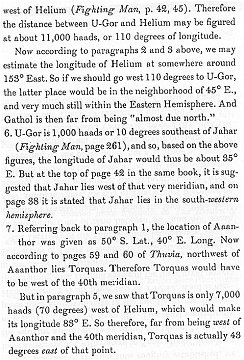
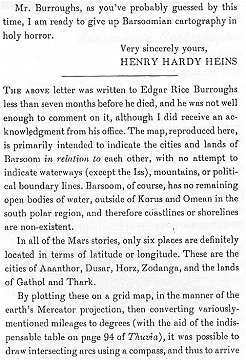 |
west of Helium (Fighting Man, p. 42, 45). Therefore
the distance between U-Gor and Helium may be figured at about 11, 000 haads,
or 110 degrees of longitude.
Now according to paragraphs 2 and 3 above, we may estimate the longitude of Helium at somewhere around 153o East. So if we should go west 110 degrees to U-Gor, the latter place would be in the neighborhood of 45o E., and very much still within the Eastern Hemisphere. And Gathol is then far from being "almost due north." 6. U-Gor is 1,000 haads or 10 degrees southeast of Jahar (Fighting Man, page 261), and so, based on the above figures, the longitude of Jahar would thus be about 35o E. But at the top of page 42 in the same book, it is suggested that Jahar lies west of that very meridian, and on page 38 it is stated that Jahar lies in the south-western hemisphere. 7. Referring back to paragraph 1, the location of Aaanthor was given as 50o S. Lat., 40o E. Long. Now according to pages 59 and 60 of Thuvia, northwest of Aaanthor lies Torquas. Therefore Torquas would have to be west of the 40th meridian. But in paragraph 5, we saw that Torquas is only 7,000 haads (70 degrees) west of Helium, which would make its longitude 83o E. So therefore, far from being west of Aaanthor and the 40th meridian, Torquas is actually 43 degrees east of that point. Mr. Burroughs, as you've probably guessed by this time, I am ready to give up Barsoomian cartography in holy horror. Very sincerely yours,
The above letter was written to Edgar Rice Burroughs less than seven months before he died, and he was not well enough to comment on it, although I did receive an acknowledgement from his office. The map, reproduced here, is primarily intended to indicate the cities and lands of Barsoom in relation to each other, with no attempt to indicate waterways (except the Iss), mountains or political boundary lines. Barsoom, of course, has no remaingin open bodies of water, outside of Koras and Omean in the south polar region, and therefore coastlines or shorelines are non-existent. In all of the Mars stories, only six places are definitely located in terms of latitude or longitude. These are the cities of Aaanthor, Dusar, Hors, Zodanga, and the lands of Gathol and Thark. By plotting these on a grid map, in the manner of the earth's Mercator projection, then converting variously-mentioned mileages to degrees (with the aid of the indispensable table on page 94 of Thuvia), it was possible to draw intersecting arcs using a compass, and thus to arrive |
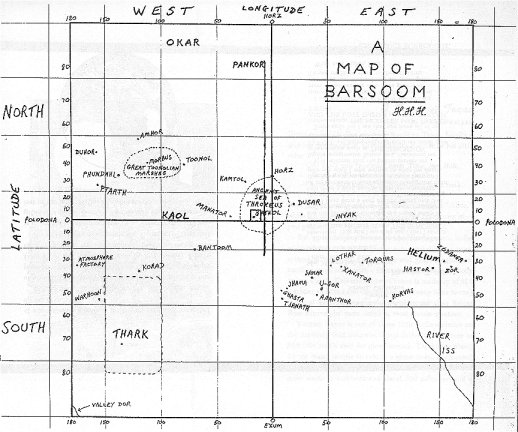
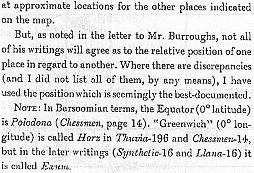
|
at approximate locations for the other places indicated
on the map
But, as noted in the letter to Mr. Burroughs, not all of his writings will agree as to the relative position of one place in regard to another. Where there are discrepancies (and I did not list all of them, by any means), I have used the position which is seemingly the best-documented. NOTE: In Barsoomian terms, the Equator (0o
latitude) is Polodona (Chessmen, page 14). "Greenwich" (0o longitude)
is called Horz in Thuvia-196 and Chessmen-14, but in the later writings
(Synthetic-16 and Llana-16) it is called Exum.
EDGAR RICE BURROUGHS, Inc. Tarzana Reseda, California November 25, 1929
My dear Mrs. Harrison:
It is believed that the public prefers my highly imaginative fiction and, therefore, my other stories, such as THE EFFICIENCY EXPERT, are being deferred until my other type of story has been exhausted. From your lies I see that you have all of my stories, except THE MONSTER MEN, TARZAN AND THE LOST EMPIRE and THE TARZAN TWINS. I am glad that you and your son like my stories. As time passes I find that more and more of my readers who have grown to manhood and womanhood are passing the Tarzan tradition along to their children. With best wishes, I am
|
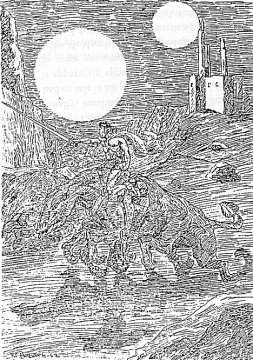 |
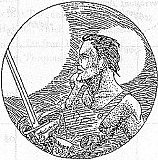
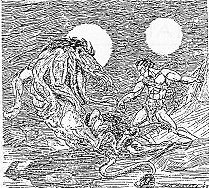 |
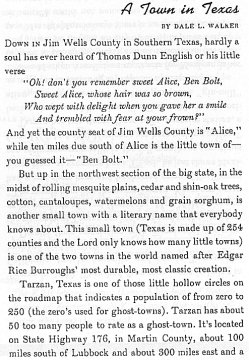 |
by Dale L. Walker Down in Jim Wells County in Southern Texas, hardly a soul has ever heard of Thomas Dunn English or his little verse. "Oh! don't you remember sweet Alice, Ben Bolt
And yet the county seat of Jim Wells County is "Alice," while ten miles due south of Alice is the little town of -- you guessed -- "Ben Bolt." But up in the northwest section of the big state, in the midst of rolling mesquite plains, cedar and shin-oak trees, cotton, cantaloupes, watermelons and grain sorghum, is another small town with a literary name that everybody knows about. This small town (Texas is made up of 254 counties and the Lord only knows how many little towns) is one of the two towns in the world named after Edgar Rice Burroughs' most durable, most classic creation. Tarzan, Texas is one of those little hollow circles on the roadmap that indicates a population of from zero to 250 (the zero's used for ghost-towns). Tarzan has about 50 too many people to rate as a ghost town. It's located on State Highway 176, in Martin County, about 100 miles south of Lubbock and about 300 miles east and a |
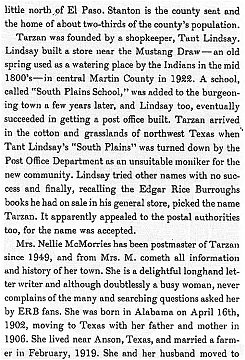
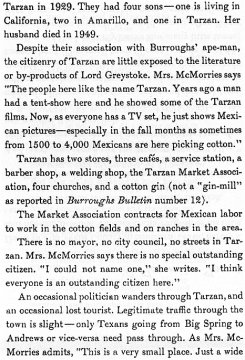 |
little north of El Paso. Stanton is the county sea
and the home of about two-thirds of the county's population.
Tarzan was founded by a shopkeeper, Tant Lindsay. Lindsay built a stone near the Mustang Draw -- an old spring used as a watering place by the Indians in the mid-1800s -- in central Martin County in 1922. A school, called "South Plains School," was added to the burgeoning town a few years later, and Lindsay too, eventually succeeded in getting a post office built. Tarzan arrived in the cotton and grasslands of northwest Texas when Tant Lindsay's "South Plains" was turned down by the Post Office Department as an unsuitable moniker for the new community. Lindsay tried other names with no success and finally, recallilng the Edgar Rice Burroughs books he had on sale in his general store, picked the name Tarzan. It apparently appealed to the postal authorities too, for the name was accepted. Mrs. Nellie McMorries has been postmaster of Tarzan since 1949, and from Mrs. M. cometh all information and history of her town. She is a delightful longhand letter writer and although doubtlessly a busy woman, never complains of the many and searching questions asked her by ERB fans. She was born in Alabama on April 16th, 1902, moving to Texas with her father and mother in 1906. She lived near Anson, Texas, married a farmer in February, 1919. She and her husband moved to Tarzan in 1929. They had four sons -- one is living in California, two in Amarillo, and one in Texas. Her husband died in 1949. Despite their association with Burroughs' ape-man, the citizenry of Tarzana are little exposed to the literature or by-producdts of Lord Greystoke. Mrs. McMorries says "The people here like the name Tarzan. Years ago a man had a tent-show here and showed some of the Tarzan films. Now, as everyone has a TV set, he just shows Mexican pictures -- especially in the fall months as sometimes from 1500 to 4,000 Mexicans are here picking cotton." Tarzan has two stores, three cafes, a service station, a barber shop, a welding shop, the Tarzan Market Association, four churches, and a cotton gin (not a "gin-mill" as reported in Burroughs Bulletin number 12). The Market Association contracts for Mexican labor to work in the cotton fields and on ranches in the area. There is no mayor, no city council, no streets in Tarzan. Mrs. McMorries says there is no special outstanding citizen. "I could not name one," she writes. "I think everyone is an outstanding citizen here." An occasional politician wanders through Tarzan, and an occasional lost tourist. Legitimate traffic through the town is slight -- only Texans going from Big Spring to Andrews or vice-versa need pass through. As Mrs. McMorries admits, "This is a very small place. Just a wide |
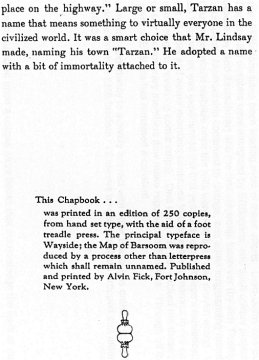 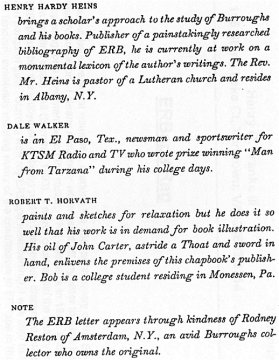 |
place on the highway." Large or small, Tarzan has
a name that means something to virtually everyone in the civilized world.
It was a smart choice that Mr. Lindsay made, naming his town "Tarzan."
He adopted a name with a bit of immortality attached to it.
This Chapbook . . . was printed in an edition of 250 copies, from hand set type, with the aid of a food treadle press. The principal typeface is Wayside; the Map of Barsoom was reproduced by a process other than letterpress which shall remain unnamed. Published and printed by Alvin Fick, Fort Johnson, New York HENRY HARDY HEINS
DALE WALKER
ROBERT T. HORVATH
NOTE:
DREAM WEAVER
|
![]()
![]()
![]()
Issue
0674

BILL
HILLMAN
Visit
our thousands of other sites at:
BILL
AND SUE-ON HILLMAN ECLECTIC STUDIO
ERB
Text, ERB Images and Tarzan® are ©Edgar Rice Burroughs, Inc.-
All Rights Reserved.
All
Original Work ©1996-2002/2018 by Bill Hillman and/or Contributing
Authors/Owners
No
part of this web site may be reproduced without permission from the respective
owners.